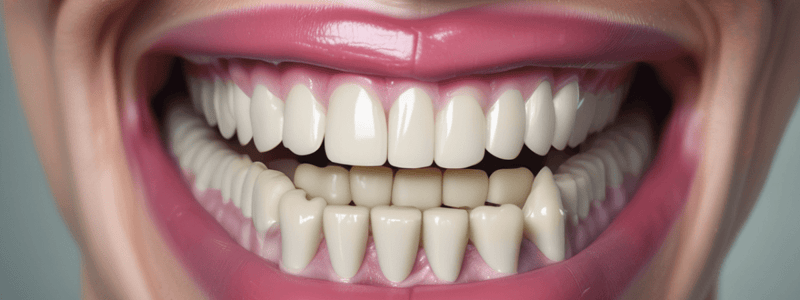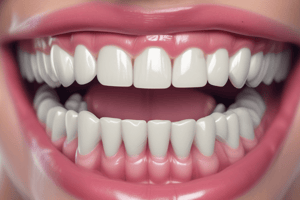Podcast
Questions and Answers
What is the definition of pulp?
What is the definition of pulp?
- A type of nerve cell in the tooth
- A type of blood vessel in the tooth
- Loose connective tissue in the center of the tooth (correct)
- A type of connective tissue in the tooth
What is the shape of the pulp?
What is the shape of the pulp?
- Cylindrical
- Similar to the tooth outline (correct)
- Tubular
- Spherical
What is the number of apical foramina?
What is the number of apical foramina?
- One or two or more (correct)
- Always three
- Always two
- Always one
Where are accessory root canals most numerous?
Where are accessory root canals most numerous?
What is the function of fibroblasts in the pulp?
What is the function of fibroblasts in the pulp?
What is the characteristic of the pulp core?
What is the characteristic of the pulp core?
What is the cell-free zone in the pulp?
What is the cell-free zone in the pulp?
What is unique about the pulp organ?
What is unique about the pulp organ?
What is the shape of the nucleus in odontoblast cells?
What is the shape of the nucleus in odontoblast cells?
What is the primary function of odontoblasts?
What is the primary function of odontoblasts?
What type of cells are found in the cell-rich zone and scattered throughout the central pulp?
What type of cells are found in the cell-rich zone and scattered throughout the central pulp?
What is the characteristic of undifferentiated mesenchymal cells?
What is the characteristic of undifferentiated mesenchymal cells?
What is the composition of the intercellular substance?
What is the composition of the intercellular substance?
What is the origin of blood vessels in the pulp?
What is the origin of blood vessels in the pulp?
What is the potential route of infection spread in the pulp?
What is the potential route of infection spread in the pulp?
What type of cells can differentiate from undifferentiated mesenchymal cells?
What type of cells can differentiate from undifferentiated mesenchymal cells?
Which type of fibers primarily mediate the sensation of pain in the pulp?
Which type of fibers primarily mediate the sensation of pain in the pulp?
What is the primary inductive role of the pulp in dental development?
What is the primary inductive role of the pulp in dental development?
What changes occur in the pulp as a result of aging?
What changes occur in the pulp as a result of aging?
Which layer of nerves is found adjacent to the cell-rich zone of the pulp?
Which layer of nerves is found adjacent to the cell-rich zone of the pulp?
Which functional role of the pulp is responsible for the sensitivity of the pulp and dentin?
Which functional role of the pulp is responsible for the sensitivity of the pulp and dentin?
Pulp stones can be classified based on their structure into which of the following categories?
Pulp stones can be classified based on their structure into which of the following categories?
What happens if the pulp is exposed to moderate stimuli?
What happens if the pulp is exposed to moderate stimuli?
Which of the following statements about calcifications in the pulp is true?
Which of the following statements about calcifications in the pulp is true?
Flashcards are hidden until you start studying
Study Notes
Pulp Structure and Development
- Loose connective tissue in the center of the tooth, developed from the dental papilla
- Consists of coronal pulp, radicular pulp or root canal, and apical foramen
Anatomy of Pulp
- Shape similar to tooth outline, with pulp horns under cusps
- Apical foramen: wide during root formation, then narrowed; 1 or 2 or more in number; 0.3-0.4 mm in size
- Accessory root canals: most numerous in apical 1/3, especially in premolars
Structural Features
- Central region: large nerve trunks and blood vessels
- Peripheral region: odontogenic region composed of odontoblasts, cell-free zone, cell-rich zone, and pulp core
- Pulp core: characterized by major vessels and nerves
Pulp Connective Tissue
- Composed of cells and intercellular substance
- Cells: fibroblasts, odontoblasts, undifferentiated mesenchymal cells, defense cells, and pulpal stem cells
- Intercellular substance: dense, gel-like, composed of acid mucopolysaccharides and protein polysaccharide compounds
Pulp Cells
- Fibroblasts: most numerous, function in collagen fiber formation, stellate shape, and extensive processes
- Odontoblasts: columnar in appearance, large oval nuclei, responsible for dentin formation
- Undifferentiated mesenchymal cells: spindle-shaped, totipotent, found in cell-rich zone
- Defense cells: histiocytes, macrophages, dendritic cells, mast cells, plasma cells, and blood vascular elements
- Pulpal stem cells: dental pulp stem cells (DPSCs) and stem cells from human exfoliated deciduous teeth (SHED)
Intercellular Substance and Blood Vessels
- Intercellular substance: dense, gel-like, composed of acid mucopolysaccharides and protein polysaccharide compounds
- Blood vessels: extensive vascularization, arise from inferior or superior alveolar artery, communicate with periodontium through apical connections and accessory canals
Nerves
- Abundant nerve supply, follows distribution of blood vessels
- Majority of nerves nonmyelinated, gain myelin sheath later in life
- Large myelinated fibers (sensory) mediate sensation of pain
- Parietal layer of nerves (plexus of Raschkow) located adjacent to cell-rich zone
Functions of Pulp
- Inductive: interacts with oral epithelial cells, leads to differentiation of dental lamina and enamel organ formation
- Formative: odontoblasts produce dentin
- Nutritive: nutrition passes from pulp to dentin
- Sensory: sensory fibers responsible for sensitivity of pulp and dentin
- Defensive: responds to moderate stimuli by forming reparative dentin
Regressive Changes (Aging)
- Cell changes: fewer cells, decreased size and number of cytoplasmic organelles
- Increased collagen fiber content
- Calcifications in and around vessels, especially near apical foramen
- Pulp stones (denticles): nodular, calcified masses in coronal and root portions of pulp organ
Pulp Stones Classification
- According to site: free from dentin, attached/fused with dentin, embedded in dentin
- According to structure: true denticles, false denticles
Studying That Suits You
Use AI to generate personalized quizzes and flashcards to suit your learning preferences.




